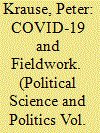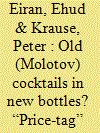|
|
|
Sort Order |
|
|
|
Items / Page
|
|
|
|
|
|
|
| Srl | Item |
| 1 |
ID:
179427


|
|
|
|
|
| Summary/Abstract |
This reflection article presents insights on conducting fieldwork during and after COVID-19 from a diverse collection of political scientists—from department heads to graduate students based at public and private universities in the United States and abroad. Many of them contributed to a newly published volume, Stories from the Field: A Guide to Navigating Fieldwork in Political Science (Krause and Szekely 2020). As in the book, these contributors draw on their years of experience in the field to identify the unique ethical and logistical challenges posed by COVID-19 and offer suggestions for how to adjust and continue research in the face of the pandemic’s disruptions. Key themes include how contingency planning must now be a central part of our research designs; how cyberspace has increasingly become “the field” for the time being; and how scholars can build lasting, mutually beneficial partnerships with “field citizens,” now and in the future.
|
|
|
|
|
|
|
|
|
|
|
|
|
|
|
|
| 2 |
ID:
186040


|
|
|
|
|
| Summary/Abstract |
Drawing on original interviews with ex-insurgents and eyewitnesses of the Second Chechen War (1999–2009), this article develops a theory of “kin killing,” defined as the use of lethal violence against insurgents’ relatives as a deliberate counterinsurgency tactic. Family-based targeting works by coercing insurgents to surrender or defect, deterring insurgents’ relatives from retaliation, and discouraging prospective recruits from joining or supporting insurgents. Because it targets a small number of individuals who have strong ties to insurgents, kin killing is the most selective form of collective violence. The tactic is most likely to be used by illiberal regimes that know the identity of the insurgents, but not their location, and operate in traditional societies with large, tightly knit families. Most would consider kin killing—and its nonlethal counterpart, kin targeting—ethically reprehensible, but numerous countries have employed it with varying degrees of success, including Russia, the United Kingdom, and China. Militarily dominant regimes who employ kin killing can turn family members from force multipliers into pressure points for insurgents, as regimes “flip the network” and make restraint, rather than revenge, the best way to protect one’s family.
|
|
|
|
|
|
|
|
|
|
|
|
|
|
|
|
| 3 |
ID:
186807


|
|
|
|
|
| Summary/Abstract |
Although only 23 people on average have been killed per year by terrorist attacks in the United States since 2001, American citizens and politicians consistently rank terrorism as a top security threat, leading to costly wars abroad and the repression of civil liberties at home. To what extent can education about terrorism alter perceptions of the threat? Much existing scholarship—and consistent polling over the past two decades—suggests that it cannot, but we disagree. Evidence gathered from an extensive series of experimental and observational surveys involving students in 31 terrorism and non-terrorism related courses at 12 universities—including massive open online courses (MOOC) and online surveys—reveals that the more individuals learn about terrorism, the smaller they perceive the threat to be to themselves and to the U.S. In the fight against terrorism and the fear it inspires, knowing really is half the battle.
|
|
|
|
|
|
|
|
|
|
|
|
|
|
|
|
| 4 |
ID:
163192


|
|
|
|
|
| Summary/Abstract |
In the early morning of July 31, 2015, masked attackers threw firebombs into two Palestinian homes in the West Bank village of Duma, south of Nablus, killing three Palestinian civilians. Contrary to claims by Israeli and Palestinian politicians, this attack was neither an isolated anomaly nor just another incident of settler violence. Instead, it was the latest attack in an important but largely unknown phenomenon called “price-tag,” in which a loosely connected group of young Israelis called “hilltop youth” burn Palestinian mosques and destroy property in hundreds of attacks accompanied by threatening graffiti that references Israeli settlers, outposts, and anti-Arab slogans. Using an original dataset of price-tag incidents and interviews with key actors, we demonstrate that the perpetrators, targets, and strategies of price-tag are different than previous patterns of settler violence. Whereas previous settlers saw the Israeli state as legitimate and largely decided to cooperate with it, the hilltop youth have decided to confront it by using price-tag attacks to deter settlement withdrawals and chain-gang the state into a conflict with the Palestinians. This analysis of the strategic logic of price-tag reveals its potential to shift the political landscape within and between Israelis and Palestinians.
|
|
|
|
|
|
|
|
|
|
|
|
|
|
|
|
| 5 |
ID:
121406


|
|
|
|
|
| Publication |
2013.
|
| Summary/Abstract |
The most striking aspect of the current scholarly debate over the political effectiveness of non-state violence is that, upon careful examination, there is not much of a debate to be found. Despite seemingly irreconcilable positions claiming that terrorism and insurgency "work" or "do not work," varying case selection and thresholds for success lie at the root of these debates, not disagreements over the empirical record. Although this previously unrecognized empirical consensus helps to resolve existing disputes, it relies on single-level strategic frameworks that fail to capture the effectiveness of violence from the perspective of those who employ it. This article presents an alternative concept of political effectiveness based on a two-level framework that accounts for the fact that insurgencies are not unitary actors, but are instead marked by armed groups that pursue strategic objectives that benefit their larger social movements (such as the overthrow of a regime or the withdrawal of enemy troops), while they simultaneously pursue organizational objectives that benefit the groups themselves (such as increasing membership or funding). Empirical analysis of eight paradigmatic campaigns common to studies of insurgency and terrorism across time and space reveals that the two-level framework better captures the political effectiveness of non-state violence than existing single-level models and primes the subfield for powerful new theories that explain greater variation in the use and effectiveness of non-state violence.
|
|
|
|
|
|
|
|
|
|
|
|
|
|
|
|
| 6 |
ID:
091061


|
|
|
|
|
| Publication |
2009.
|
| Summary/Abstract |
The United States cannot defeat al-Qaeda by strength of arms alone. It must also change the terms of debate in the Arab/Muslim world, especially in its radical wing. How can this best be accomplished? What strategy should the United States adopt for what is often called the war of ideas against radical Islam?
|
|
|
|
|
|
|
|
|
|
|
|
|
|
|
|
| 7 |
ID:
127890


|
|
|
|
|
| Publication |
2013.
|
| Summary/Abstract |
When and why do national movements succeed? What explains variation in the use and effectiveness of political violence employed by nationalist groups? Groups pursue common strategic goals against external enemies, such as the founding of a new state, while engaging in zero-sum competition for organizational dominance with internal rivals in their national movement. The distribution of power within a national movement provides its structure, which serves as the key variable for both the internal and external struggle. The hierarchical position of groups within the movement drives their actions, while the number of significant groups in the movement drives its effectiveness. Contrary to existing scholarship that treats nonstate coercers as unitary or suggests that united or fragmented movements perform best, hegemonic movements with one significant group are most likely to succeed. Hegemonic movement structure incentivizes the pursuit of shared strategic goals; reduces counterproductive violent mechanisms and foreign meddling; and improves the movement's coherence in strategy, clarity in signaling, and credibility in threats and assurances to yield strategic success. Analysis of seventeen campaigns involving sixteen groups within the Palestinian and Algerian national movements reveals that the power distribution theory explains greater variation in the effectiveness of national movements than previous scholarship.
|
|
|
|
|
|
|
|
|
|
|
|
|
|
|
|
|
|
|
|
|